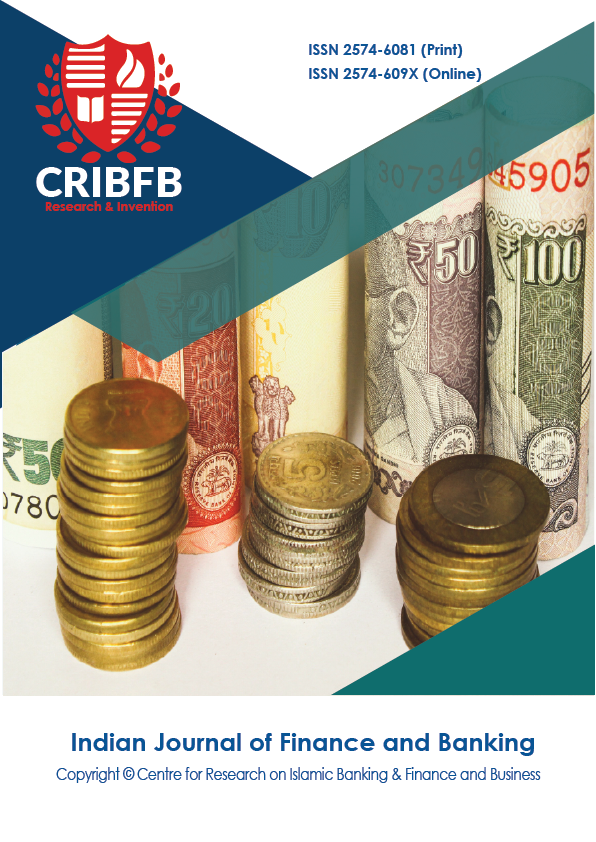IMPACT OF PRADHAN MANTRI JAN DHAN YOJANA PROGRAM ON ACCESS TO CREDIT
Abstract
This research paper investigates the impacts of the Pradhan Mantri Jan Dhan Yojana (PMJDY) program on access to credit for individuals living below the poverty line in India since its inception in 2014. The PMJDY initiative aims to enhance financial inclusion and alleviate poverty by providing banking services and credit access to marginalized populations. The paper begins with a comprehensive literature review, tracing the historical context of financial inclusion in India, the evolution of policies, and previous research on the subject. It then delves into the PMJDY program's features, implementation, and progress, highlighting its efforts to offer zero-balance accounts and overdraft facilities. The paper employs regression analyses, both at the national and district levels, to examine the relationship between various factors, such as GDP per capita, population density, literacy rates, and PMJDY adoption. These analyses had shed light on the success of the PMJDY program in advancing financial inclusion throughout different regional dynamics. The findings provide insights into the program's effectiveness in improving credit access for the economically disadvantaged. Ultimately, this research contributes to the ongoing discourse on financial inclusion and informs policymakers on strategies to combat poverty and foster inclusive economic growth especially with policies relating to credit access.
JEL Classification Codes: C00, B21, G18, G53.
References
Bardhan, P. (1984). Land, labor, and rural poverty: Essays in development economics. Oxford University Press. https://doi.org/10.1007/978-981-16-4181-7_19
Bhushan, P., & Medury, Y. (2013). Financial Literacy and its Determinants. International Journal of Engineering, Business and Enterprise, 4(2), 155-160.
Banerjee, A. V., & Duflo, E. (2019). Good economics for hard times. PublicAffairs.
Das, D., & Ghosh, S. (2020). Financial inclusion in India through PMJDY: An overview. International Journal of Research in Commerce, Economics and Management, 10(2), 41-50. https://doi.org/10.1177/1391561420961649
Demirgüç-Kunt, A., & Singer, D. (2017). Financial inclusion and inclusive growth: A review of recent empirical evidence. World Bank Policy Research Working Paper, (8040). https://doi.org/10.1596/1813-9450-8040
Dutta, P. (2022). Financial Inclusion in India: An Intertemporal Study. In Persistent and Emerging Challenges to Development: Insights for Policy-Making in India (pp. 411-432). Singapore: Springer Nature Singapore.
Lenka, S. K., & Sharma, R. (2017). DOES FINANCIAL INCLUSION SPUR ECONOMIC GROWTH IN INDIA? The Journal of Developing Areas, 51(3), 215–228. Retrieved from https://www.jstor.org/stable/26416941
Pingali, P. (2012). Green revolution: Impacts, limits, and the path ahead. Proceedings of the National Academy of Sciences, 109(31), 12302-12308. https://doi.org/10.1073/pnas.0912953109
Rajan, R. (2014). Governor's address: Financial inclusion in India. Reserve Bank of India.
Sarma, M. (2008). Index of financial inclusion. Economic and Political Weekly, 43(18), 47-54. Retrieved from http://hdl.handle.net/10419/176233
Zulfiqar, K., Chaudhary, M. A., & Aslam, A. (2016). Financial inclusion and its implications for inclusive growth in Pakistan. Pakistan Economic and Social Review, 54(2), 297-325. Retrieved from https://www.jstor.org/stable/26616711
Copyright (c) 2023 Neeraj Shah

This work is licensed under a Creative Commons Attribution 4.0 International License.


